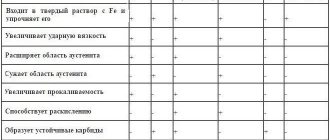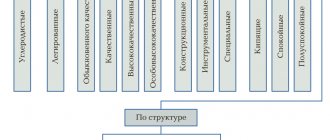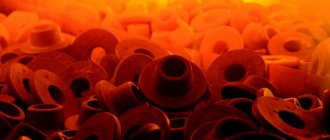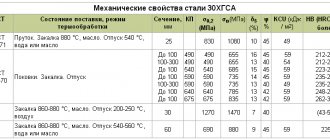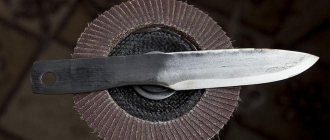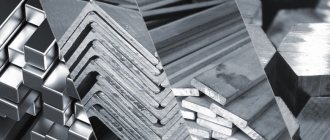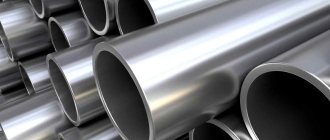Application
Grade C245 is used for the production of sheet and shaped rolled products - equal and unequal angles, channels, T-beams, I-beams. Rolled steel is used in the production of metal structures for various purposes. Due to their good weldability, welded joints are widely used in their production.
Particularly critical structures operating under conditions of constant increased vibration loads are required to be connected with rivets or other methods that prevent the spread of possible cracks.
As analogues of steel grade C245 we can name steel St.3ps, steel St.3sp, which are similar in mechanical properties and chemical composition. It should be noted that a mandatory requirement is the complete or partial completion of deoxidation of steels before the process of casting into molds. This is indicated by the letters ps and sp in the designation of brands.
Low-alloy structural steel C245 has properties that meet the requirements for metal structures for general use.
It can be welded well by all types of welding without additional measures to reduce red and blue brittleness.
The steel has average corrosion resistance. This requires the use of protective paint and varnish coatings for metal structures made from the described steels used outdoors.
Steel S355
Low-alloy structural steel for welded structures and welded parts operating under pressure at temperatures from -40 to +475 °C.
S355 is steel produced according to European Union standards. The marking of steel S355 is deciphered as follows: the letter S indicates that it belongs to structural steels, the number 355 indicates a yield strength of 355 N/mm. sq.
S355J2 steel (S355J2+N, S355J2+AR or S355J2+M) is a low carbon, low alloy steel. The main alloying element is manganese. Thanks to it, steel acquires the property of elasticity. The second alloying element is silicon. It increases the ductility of steel. In combination with manganese, silicon increases the elastic limit. As a result, S355 steel has excellent resistance to impact loads.
Due to its low carbon content, S355 steel has no restrictions on weldability.
Due to its properties, S355 steel is used in welded structures subject to alternating loads, including impact loads.
Depending on the type, S355 steel is used for the production of:
- mining, earth-moving equipment,
- handling equipment,
- steel supports (including those subject to strong wind loads),
- elements of building structures.
Steel S355 is an analogue of domestic steel grade 17G1S.
The quality standard of S355 steel is determined according to EN 10025-2.
Chemical composition in % of steel S355J2
| Nominal product thickness (mm) | C | Si | Mn | P | S | Cu | Fe |
| ≤ 40 | <0,20 | <0,55 | <1,60 | <0,025 | <0,025 | <0,55 | Rest |
| > 40 | <0,22 | <0,55 | <1,60 | <0,025 | <0,025 | <0,55 | Rest |
For profiles with nominal thickness > 100 mm carbon content (C) by agreement. For long products, the P content may be increased by 0.005%, the maximum S content may be increased by 0.015% by agreement to improve machinability if the steel is processed to change the sulphide structure and the chemical composition shows a minimum Cu content of 0.002%. Copper (Cu) content higher than 0.40% may result in flaking corrosion (hot brittleness).
Maximum carbon equivalent value
| Nominal product thickness (mm) | CEV (%) |
| ≤ 30 | 0,45 |
| > 30 ≤ 150 | 0,47 |
| > 150 ≤ 400 | 0,49 |
Formula for determining the CEV parameter:
CEV = C + Mn/6 + (Cr + Mo + V)/5 + (Ni + Cu)/15
If the copper (Cu) content is in the range of 0.25% and 0.40% in the ladle sample and in the range of 0.20% and 0.45% in the product analysis, then the maximum carbon equivalent value CEV should be increased by 0 .02%.
Where products are supplied with controlled silicon (Si) content, for example for hot-dip galvanizing, and it may be necessary to increase the content of other elements such as carbon (C) and manganese (Mn) to obtain the required tensile properties, then the maximum carbon equivalent values should be increased as follows: - for Si < 0.030%, increase in CEV by 0.02%; — for Si < 0.25%, increase in CEV by 0.01%.
Due to the low carbon content, s355j2 steel, the properties of which are determined by its chemical composition, is characterized by high weldability and suitability for stamping and other types of mechanical cold working. This material is subject to further production for the manufacture of parts and elements in a wide area of industrial production.
Steel S355
Steel grade S355 is one of the most popular grades of structural steel supplied by Eurometal to Ukraine. S355 steel is used to produce both sheet metal and all types of long products - I-beams, channels, angles, profile pipes and round pipes.
| Why is this particular steel so popular in Ukraine? It’s very simple - S355 steel is an analogue of Russian steel 17GS and 17G1S, and in Ukraine this steel serves as a replacement for 09G2S steel, which is widely used both in construction and mechanical engineering. It is as a replacement for 09G2S steel that in most cases I-beams, channels, pipes and sheets made from S355J2 steel are supplied to Ukraine. This replacement is due to the fact that in Ukraine there is a certain problem in purchasing a wide range of rolled metal from 09G2S steel, especially for profile pipes, I-beams and thin (from 3 to 6 mm) sheets. In Europe, the entire range of rolled metal products is easily available from S355J2 steel, so if the customer needs to quickly deliver rolled metal products or needs a small amount of metal, then the best way out of the situation would be to supply European rolled metal products made from S355 steel. Due to the fact that the characteristics of these steels are the same, as a rule, no additional approvals or difficulties with replacement arise. |
S355 (ES 355) is a “folk” name, widespread among professionals in the metal construction and metalworking market. The full name of this steel grade is S355J2 (S355J2+N, S355J2+AR or S355J2+M)
S355J2 steel is a structural steel (S) with a minimum yield strength of 355 MPa (1 MPa = N/mm2) at ambient temperature and a work of failure on impact of 27 J measured at -20°C
Source
Overview of steel grade C345
Since people discovered metal, they have learned to use it in almost all areas of life. Moreover, each application requires specific characteristics from the metal. Therefore, in the modern world there are thousands of types of metals and alloys. One of the well-known and commonly used grades is C345 steel.
Steel strength classes and quality category for cold resistance
In the manufacture of various metal structures, pipes and pipeline fittings on the Russian market, two grades of steel are most often used: st.20 and 09g2s. The popularity of materials is due to their performance properties, good weldability, and a wide range of operating temperatures.
Steels are used in mechanical engineering, the oil and gas sector, the chemical industry and other areas for the production of:
- bends, transitions, tees and other fittings;
- pipes;
- shut-off and control valves;
- welded structures;
- cars and trailers;
- various parts.
Despite similar areas of application, steel grades differ in composition, and, consequently, in technological and mechanical properties. Therefore, the material is selected based on state and industry standards, technical specifications and design documentation.
Description
Due to its low carbon content, S355J2 is primarily intended for welded and stamped products. Its weldability has no restrictions and therefore the production of the most popular types of rolled products from it has been established. Thanks to the balanced chemical composition, welded parts made from this alloy operate at high pressures and temperature limits from -40 to +480 degrees. Due to its high tensile strength, it is widely used in various fields of technology. The low-alloy, silicon-manganese alloy is subjected to a hardening treatment through controlled rolling and intense cooling. Since the alloy tolerates high temperatures well, it is used for pipes carrying steam and hot water. Flanges, tees and other shaped fittings are also made from it. A large amount is used when drawing gas pipelines, thermal pipelines and highways moving inactive gases. The Russian analogue of steel S355J2 is steel 17GS and 17G1S. These steel grades have high tensile strength and high impact strength. A lot of this steel is used in the carriage building, automotive industry, and in the production of power transmission line supports. Bridges, oil and gas offshore platforms are built from it. This steel is irreplaceable in the production of heavy-duty vehicles, lifting equipment, and bulldozers. Critical parts and assemblies in the energy industry are made from it. According to EN 10025-2, manufactured products are presented in the form of flat and long products, as well as billets, which are further used in the production of long and non-standard products. Component composition and strength characteristics are regulated by standard EN 10025-2:2004
steel grade, analogues, explanation, characteristics
In the production of metal structures, C245 steel is a low-carbon grade used for building structures.
Chemical composition
Steel consists of approximately:
- 98% iron,
- 0.2% carbon,
- 0.65% manganese,
- from 0.05 to 0.015% silicon,
- up to 0.3% chromium, nickel and copper combined.
The presence of up to 0.05% sulfur, 0.04% phosphorus and 0.08% arsenic is allowed.
Decoding steel C245
In the designation of steel, the letter C means “construction”, the numbers 245 are the yield strength (T) in megapascals (MPa). In more conventional units σT = 24.5 kg/sq. mm.
Among other parameters characterizing the mechanical properties of steel, we note the tensile strength = 370 MPa (37 kg/sq. mm).
Weldability
To assess weldability, use the criterion of carbon equivalent, calculated by the formula
Se=C+G/6+X/5+(N+D)/15, where C, G, X, N, D – the amount of carbon, manganese, chromium, nickel and copper as a percentage in the composition of the steel or alloy.
For C245, the equivalent carbon is below 0.25%, which means good weldability. The weld seam is not prone to the formation of hot and cold cracks. Parts can be welded by any method without additional measures - preheating, forging the heat-affected zone, etc.
Plastic
Plastic qualities, i.e. the ability to deform in a cold state without signs of destruction, are characterized by the relative elongation of the sample at break and the size of the yield area.
Steel C245 has a relative elongation at break, i.e., the elongation of the sample relative to the initial size after fracture, of 25%.
The length of the yield plateau, i.e. the change in relative elongation at which the stress does not change, is at least 2.5%.
This indicates the possibility of bending and stamping thin sheets of steel. For thick ones, local heating should be used to avoid cracks.
To understand the difference in the deformation capacity of thin and thick sheets, you should refer to the course on strength of materials. When bending a sheet, the difference in changes in the dimensions of the outer and inner sides will be greater, the greater the thickness. This means that for a thick sheet, the relative deformation will be greater and the probability of destruction - the appearance of cracks - will be higher.
What can be replaced?
Category C345 can be replaced by many alternative alloys, for example, 09G2S. Items from both brands have identical composition, but the latter has up to 0.08% (As) arsenic. This analogue is often used in industry for servicing metal structures operating under high pressure or at T = from -70 to +425 °C. The name contains the sign “G”, which means manganese, and the number 2 indicates its percentage (2%). Indicator 09 indicates total carbon (0.9%).
Application
Structural low-alloy silicon-manganese steel S355 has a wide range of applications in construction, metallurgy, mining, mechanical engineering, machine tool building, energy, and bridge construction. Various rolled metal products, thick and thin sheets, pipes, I-beams, angles, channels, and squares are made from steel S355. Rolled products from S355 are used for the manufacture of:
- critical supporting and load-bearing structures;
- heat exchangers;
- buildings;
- parts and spare parts for cars, agricultural machinery, earth-moving and lifting mechanisms;
- flanges, fans, pumps;
- transport gas and oil pipelines;
- construction supports;
- containers;
- tanks
Steel s235: characteristics and scope of application
A variety of rolled products for welded metal structures are produced from carbon steel of this grade. The standards and parameters of the material are indicated in GOST 27772, which allows the use of steel c235 in the production of channels (GOST 8240), equal and unequal angles (GOST 8509 and GOST 8510), rolled sheets (GOST 19903), I-beams (GOST 8239, 26020), and also various bent profiles and corrugated sheets.
This material can be classified as universal, since it can be purged with argon, vacuumed, modified, and processed with synthetic slags. According to the state standard, marking of shaped rolled products made from steel grade C235 is carried out with brown or yellow paint.
Mechanical properties and weldability of steel grade C235
Steel for building structures grade C235 has excellent mechanical properties, allowing it to be widely used for the production of building and industrial steel structures, including those with welded joints. The yield strength of this material varies between 195-235 MPa, the short-term strength limit is 360 MPa. At the same time, the relative elongation of steel at break is at the level of 20-24%.
This metal boasts excellent weldability, so it can be used to create complex weldable structures with virtually no restrictions. S235 steel does not require heating or heat treatment prior to welding, while other grades of similar material are limited in weldability (require heating to 100-120°C) or difficult to weld (200-300°C plus annealing after welding).
In relation to the chemical composition of the metal, GOST 27772-88 defines the following maximum impurity values (in percent):
Features of using steel s235
In the standard designation “c235”, the symbol C indicates “construction” steel, and the numbers indicate the approximate yield strength. Products made from this material are welded with electrodes of type E42, E42a, E46 and E46a, and structural elements that will operate under conditions of strong vibration or dynamic loads, as well as at strong negative temperatures (-40 ° C and below), should be welded with electrodes indicated in the designation which contain the letter “a”. Examples of such structures are crane beams, long transport overpasses and other spans. The same welding technology is used to connect high-pressure pipelines and volumetric sheet structures. To produce any products from steel C235, hot rolling technologies are used. Additionally, if necessary, to provide the finished rolled product with a set of required properties, heat treatment can be applied to it. Today it is the most popular metal for creating rolled products, which will subsequently be used in welded structures.
Examples of marking steels of various types
Determining the grade of steel and assigning an alloy to a certain type is a task that should not cause any problems for a specialist. You don’t always have a table at hand that gives a breakdown of brand names, but the examples given below will help you figure it out.
Content of elements in common steel grades (click to enlarge)
Structural steels that do not contain alloying elements are designated by the letter combination “St”. The numbers following are the carbon content, calculated in hundredths of a percent. Low-alloy structural steels are marked somewhat differently. For example, 09G2S steel contains 0.09% carbon, and alloying additives (manganese, silicon, etc.) are contained within 2.5%. 10KhSND and 15KhSND, which are very similar in their markings, differ in different amounts of carbon, and the share of each alloying element in them is no more than 1%. That is why there are no numbers after the letters indicating each alloying element in such an alloy.
Read also: Soldering iron for polypropylene pipes how to use video
20Х, 30Х, 40Х, etc. – this is how structural alloy steels are marked; the predominant alloying element in them is chromium. The number at the beginning of such a mark is the carbon content in the alloy in question, calculated in hundredths of a percent. The letter designation of each alloying element can be followed by a number, which is used to determine its quantitative content in the alloy. If it is not there, then the specified element in the steel contains no more than 1.5%.
You can consider an example of the designation of chromium-silicon-manganese steel 30KhGSA. According to the labeling, it consists of carbon (0.3%), manganese, silicon, and chromium. It contains 0.8–1.1% of each of these elements.
Designation of steels with alloying elements
As mentioned above, the classification of steels with alloying elements includes several categories. The marking of alloy steels is compiled according to certain rules, knowledge of which allows one to quite simply determine the category of a particular alloy and the main area of its application. In the initial part of the names of such brands there are numbers (two or one) indicating the carbon content. Two numbers indicate its average content in the alloy in hundredths of a percent, and one – in tenths. There are also steels that do not have numbers at the beginning of the brand name. This means that the carbon content in these alloys is within 1%.
Example of alloy steel marking
The letters that can be seen behind the first digits of the brand name indicate what the alloy is made of. The letters that give information about a particular element in its composition may or may not be followed by numbers. If there is a number, then it determines (in whole percentages) the average content of the element indicated by the letter in the alloy, and if there is no number, it means that this element is contained in the range from 1 to 1.5%.
At the end of the marking of certain types of steel there may be the letter “A”. This suggests that this is high quality steel. These grades may include carbon steels and alloys with alloying additives in their composition. According to the classification, this category of steels includes those in which sulfur and phosphorus amount to no more than 0.03%.
What does the steel marking mean?
It has become quite easy to decipher the brand; you just need to have certain information. Structural steels of ordinary quality and not containing alloying elements are marked with the letter combination “St”. By the number following the letters in the name of the brand, you can determine how much carbon is in such an alloy (calculated in tenths of a percent). The numbers may be followed by the letters “KP”: from them it becomes clear that this alloy has not completely gone through the deoxidation process in the furnace, and accordingly, it belongs to the boiling category. If the brand name does not contain such letters, then the steel corresponds to the calm category.
Chemical composition of carbon structural steels of ordinary quality
Structural unalloyed steel, which belongs to the quality category, has two numbers in its designation; they are used to determine the average carbon content in it (calculated in hundredths of a percent).
Before we begin to consider the grades of those steels that include alloying additives, you should understand how these additives are designated. Marking of alloy steels may include the following letter designations:
List of alloying additives used
Manufacturing Features
The manufacturing process of this grade of steel is not too complicated. Everything happens under the influence of a temperature of about 1550°C. Several stages can be distinguished here.
- First of all, the iron is heated and left for some time until it melts.
- They cleanse from unnecessary impurities that float to the surface.
- Next, add the necessary components and cool.
Steel S235, S245, S255, S275, S285, S345, S375, S390, S440, S590, construction steel
Construction steel (C235, C245, C255, C275, C285, C 345, C375, C390, C440, C590) is used: - for the production of rolled metal intended for building steel structures with welded and other connections;
Brands according to current regulatory and technical documentation
| Name of steel | Steel grades according to current standards |
| S235 | St3kp2 |
| S245 | St3ps5, St3sp5 |
| S255 | St3Gps, St3Gsp |
| S275 | St3ps |
| S285 | St3sp, St3Gps, St3Gsp |
| S345 | 12G2S, 09G2S |
| S345D | 12G2SD |
| S345D | 09G2SD |
| S345K | 10KhNDP |
| S375 | 12G2S |
| S375D | 12G2SD |
| S390 | 14G2AF |
| S390D | 14G2AFD |
| S390K | 15G2AFDps |
| S440 | 16G2AF |
| S440D | 16G2AFD |
| S590 | 12G2SMF |
| S950 | 12G2MFAYU |
State Enterprise Stalmash ships metal products from a warehouse in Yekaterinburg: *for pickup, *containers, *wagons, *shipping by road transport companies throughout Russia, *shipment through railway forwarding.
Current information about FULL availability in the warehouse, prices, SHIPMENT conditions by calling State Enterprise “Stalmash” (343) 213-1014, (343) 219-2003, (343) 268-0789, (343) 268-6735, (343) 268 -7815
Rolled metal from State Enterprise Stalmash, LLC [open for viewing]
The closest equivalents (analogues) of steel Q345
| Euronorms (EN) | 1.0539, 1.0545, 1.0546, 1.0549, 1.0594, 1.0596, 1.8823, 1.8834, 1.8845, 1.8846, Fe 150 DD2, Fe 510 DD2, S355K2, S355K2C, S355K2G4, S3 55M, S355MH, S355ML, S355MLH, S355N, S355NH, S355NL, S355NLH |
| USA (ASTM) | Grade 50, K02303, K02304, K02305, K02306 |
| China (GB/T) | L03451, L03452, L03453 |
| Russian analogues (GOST) | 09G2, 09G2S, 10G2B, 10G2S, 10HSND, 10HSNDA, 12GS2S, 12G2F, 14KHS, 14KHGNDTS, 15GF, 15HSND, 17G1S, 17GS, 325, 345, 355, 375, NL-2, S HL2, S345, S355 |
Characteristics of material C235.
Chemical composition in % of material - C235
| Brand: | S235 |
| Substitute: | St3kp2 |
| Classification: | Steel for building structures |
| Application: | production of rolled products intended for building steel structures with welded and other connections |
| C | Si | Mn | Ni | S | P | Cr | N | Cu |
| up to - 0.22 | up to - 0.05 | up to - 0.6 | up to - 0.3 | up to - 0.05 | up to - 0.04 | up to - 0.3 | up to - 0.012 | up to - 0.3 |
Technological properties of material C235.
Mechanical properties at T=20oC of material C235.
| Assortment | Size | Eg. | sв | sT | d5 | y | KCU | Thermal change |
| — | mm | — | MPa | MPa | % | % | kJ/m2 | — |
| Sheet | 2 — 3.9 | - | 360 | 235 | 20 | - | - | - |
| Mechanical properties : | |
| sв | — Short-term strength limit, [MPa] |
| sT | — Proportional limit (yield strength for permanent deformation), [MPa] |
| d5 | — Elongation at break, [%] |
| y | — Relative narrowing, [%] |
| KCU | — Impact strength, [kJ/m2] |
| HB | — Brinell hardness, [MPa] |
Hot rolled sheet Steel S355J:
Update date: November 21, 2018
Source of the article: https://sumkivtrende.ru/drugoe/stal-s355.html
| Other names | South Africa (SANS 50025-2) | S355J2, 1.0577 |
| European (EN 10025-2) | S355J2, 1.0577 | |
| USA (ASME SA/EN 10025-2) | S355J2, 1.0577 | |
| Classification | Structural quality non-alloy steel | |
| — | 17 | |
| > 150 ≤ 250 | 17 | 17 |
| > 100 ≤ 150 | 18 | 18 |
| > 63 ≤ 100 | 18 | 20 |
| > 40 ≤ 63 | 19 | 21 |
| > 3 ≤ 40 | 20 | 22 |
| Lo = 80 mm | ||
| > 2,5 ≤ 3 | 16 | 18 |
| > 2 ≤ 2,5 | 15 | 17 |
| > 1,5 ≤ 2 | 14 | 16 |
| > 1 ≤ 1,5 | 13 | 15 |
| 250 ≤ 400 | 27 | — 20 |
| > 150 ≤ 250 | 27 | — 20 |
| ≤ 150 | 27 | — 20 |
Physical and mechanical properties
St3 steel is the most used grade of metal used in construction and mechanical engineering. Low price combined with physical and mechanical properties that determined the popularity of this material.
Let us list the mechanical indicators of St3:
- yield strength 205-255 MPa;
- temporary tensile strength 370-490 MPa;
- relative elongation 22-26%;
- impact strength at temperature:
- 20 0C is 108 J/cm2;
- 20 0C equals 49 J/cm2;
- hardness HB 10-1: 131 MPa.
Strength indicators: yield strength and relative elongation depend on the thickness and shape of the rolled product. The greater the thickness of the rolled metal, the lower the value of the indicator; the lowest indicators are for pipes, the highest indicators are for sheets with a thickness of 5-10 mm.
The density of St3 is 7850 kg/m3. The alloy is a highly weldable material.
Prices for non-ferrous metals and precious metals
Characteristics of S355J2 steel.
| Standard | Hot rolled products from structural steels. Part 2: Technical delivery conditions for non-alloy structural steels (EN 10025-2) | |
| Application | Welded structures, hot-rolled steel | |
| Former designation | European old (EN 10025-2:1990) | Fe 510 D2, Fe 510 D1 |
| European old (EN 10025:1990 + A1:1993) | S355J2G3, 1.0570 | |
Low-alloy steel S355J2 belongs to the class of structural steels (letter S) with a minimum fluidity value of 355 MPa at a working temperature of 20 degrees and a destructive impact work of 27 J. For thicknesses from ... to. Flow tests are carried out on rolled normalized products (+N) or on rolled billets (+AR). Products manufactured in a normalized state (+N) can subsequently be used for hot and cold stamping, or other types of cold machining of metals.
C235 | LLC "StalExpress"
This page shows the technical, mechanical and other properties, as well as the characteristics of steel grade C235.
Classification of material and application of grade C235
Grade: C235 Material classification: Steel for building structures Application: production of rolled products intended for building steel structures with welded and other connections
Chemical composition of C235 material in percentage terms
Mechanical properties of C235 at a temperature of 20oC
| Assortment | Size | Eg. | sв | sT | d5 | y | KCU | Thermal change |
| — | mm | — | MPa | MPa | % | % | kJ/m2 | — |
| Sheet, GOST 27772-88 | 360 | 195-235 | 20-24 |
Technological properties of C235
Explanation of symbols, abbreviations, parameters
| Mechanical properties : | |
| sв | — Short-term strength limit, [MPa] |
| sT | — Proportional limit (yield strength for permanent deformation), [MPa] |
| d5 | — Elongation at break, [%] |
| y | — Relative narrowing, [%] |
| KCU | — Impact strength, [kJ/m2] |
| HB | — Brinell hardness, [MPa] |
| Weldability: | |
| no limits | — welding is performed without heating and without subsequent heat treatment |
| limited weldability | — welding is possible when heated to 100-120 degrees. and subsequent heat treatment |
| difficult to weld | — to obtain high-quality welded joints, additional operations are required: heating to 200-300 degrees. during welding, heat treatment after welding - annealing |
Other brands in this category:
Mechanical processing
Machining of C355 is simple, it consists of:
- turning and milling works;
- drilling and cross-cutting;
- flexible;
- edits;
- shot processing;
- sandblasting.
Heat treatment, welding, forging
The plasticity of rolled C355 and the “ps” deoxidation method contribute to the uniformity of the structure and prevent the formation of cracks and cavities. Any maintenance method is suitable for S355: hardening, tempering, annealing. Hardening increases the strength of rolled metal C355 and other performance characteristics. Tempering relieves internal stress and extends service life. Annealing normalizes the uniformity of the crystal structure. But as a result of annealing, the ductility of the metal may decrease. Therefore, it is necessary to observe the manufacturability of operations and holding time.
C355 has good weldability using various welding methods without heating and with preheating followed by high temperature processing. Thick-sheet products from this brand are welded using multi-layer welding.
Forging C355 does not differ much from other brands. It is carried out, depending on the forging method and nomenclature requirements, while observing the temperature range from + 1250 ° C to +800 ° C.
Steel for building structures C235 - characteristics, properties, analogues
This page shows the technical, mechanical and other properties, as well as the characteristics of steel grade C235.
Classification of material and application of grade C235
Grade: C235 Material classification: Steel for building structures Application: production of rolled products intended for building steel structures with welded and other connections
Chemical composition of C235 material in percentage terms
Mechanical properties of C235 at a temperature of 20oC
| Assortment | Size | Eg. | sв | sT | d5 | y | KCU | Thermal change |
| — | mm | — | MPa | MPa | % | % | kJ/m2 | — |
| Sheet, GOST 27772-88 | 360 | 195-235 | 20-24 |


